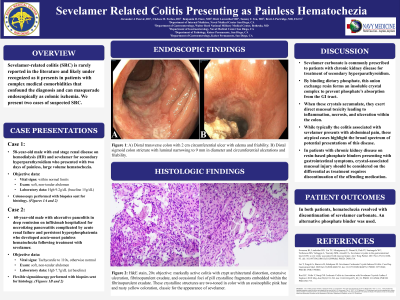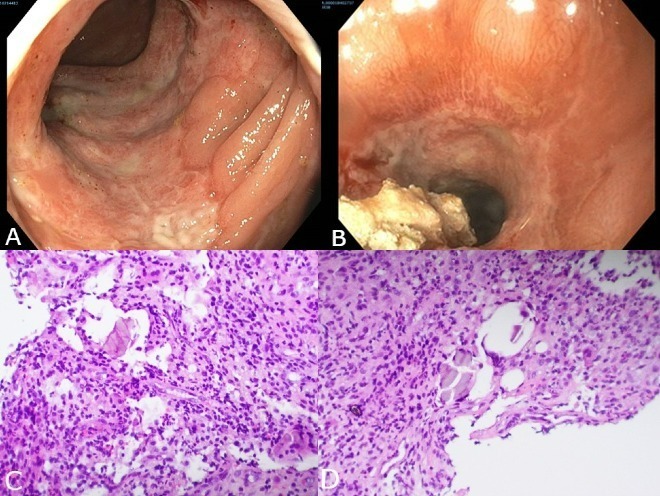Back


Poster Session C - Monday Afternoon
Category: Colon
C0154 - Sevelamer-Related Colitis Presenting as Painless Hematochezia
Monday, October 24, 2022
3:00 PM – 5:00 PM ET
Location: Crown Ballroom

Has Audio

Alexander Pazevic, DO
Naval Medical Center San Diego, CA
Presenting Author(s)
Alexander Pazevic, DO1, Chelsea Forbes, MD2, Benjamin Fiore, MD1, Brett Lowenthal, MD3, Tommy Yen, MD3, Brett Partridge, MD, FACG3
1Naval Medical Center San Diego, San Diego, CA; 2Walter Reed National Military Medical Center, Bethesda, MD; 3Kaiser Permanente, San Diego, CA
Introduction: Sevelamer-related colitis (SRC) is rarely reported in the literature and likely underrecognized as it presents solely in patients with complex medical comorbidities that potentially confound the diagnosis and can masquerade endoscopically as colonic ischemia. We present two cases of painless hematochezia in patients with suspected SRC.
Case Description/Methods: Case 1: 58-year-old male with end stage renal disease on hemodialysis (HD) presented with two days of painless, large volume hematochezia resulting in acute anemia with hemoglobin (Hgb) of 9.2g/dL. His vital signs were within normal range and his abdomen was soft and nontender. Medication list was notable for sevelamer carbonate for secondary hyperparathyroidism. Colonoscopy demonstrated a 2cm circumferential ulcer in the distal transverse colon (Figure 1a) with histopathologic findings of active colitis with ulceration, marked crypt distortion, and rare foci of pill crystalline fragments within the fibrinopurulent exudate which were morphologically consistent with sevelamer (Figure 1c).
Case 2: 60-year-old male with ulcerative pancolitis in deep remission on infliximab who developed acute onset, painless, and profound hematochezia during protracted hospitalization for idiopathic acute necrotizing pancreatitis complicated by acute renal failure requiring 2 weeks of treatment with HD and sevelamer carbonate for persistent hyperphosphatemia. On evaluation, he was notably tachycardic with HR 110s but normotensive with a soft, nontender abdomen and Hgb near his baseline at 7.7g/dL. Flexible sigmoidoscopy revealed a 9mm circumferential stricture with ulceration in the distal sigmoid colon (Figure 1b) which was extensively biopsied revealing exuberant granulation-type tissue and fibrinopurulent exudate with admixed fragments of pill crystalline material that is morphologically consistent with sevelamer (Figure 1d).
In both cases sevelamer was discontinued with resolution of hematochezia.
Discussion: Sevelamer is a commonly prescribed medication which is linked with gastrointestinal mucosal injury. Although difficult to distinguish from colonic ischemia or alternative causes of drug induced colitis it is important to maintain a high index of suspicion. For pathologists, obtaining multiple histological levels is important to identify the pill crystalline structures. Multidisciplinary management with nephrology is prudent to assess if the patient is a candidate for an alternative phosphate binder as this may reduce the risk of recurrent colitis.

Disclosures:
Alexander Pazevic, DO1, Chelsea Forbes, MD2, Benjamin Fiore, MD1, Brett Lowenthal, MD3, Tommy Yen, MD3, Brett Partridge, MD, FACG3. C0154 - Sevelamer-Related Colitis Presenting as Painless Hematochezia, ACG 2022 Annual Scientific Meeting Abstracts. Charlotte, NC: American College of Gastroenterology.
1Naval Medical Center San Diego, San Diego, CA; 2Walter Reed National Military Medical Center, Bethesda, MD; 3Kaiser Permanente, San Diego, CA
Introduction: Sevelamer-related colitis (SRC) is rarely reported in the literature and likely underrecognized as it presents solely in patients with complex medical comorbidities that potentially confound the diagnosis and can masquerade endoscopically as colonic ischemia. We present two cases of painless hematochezia in patients with suspected SRC.
Case Description/Methods: Case 1: 58-year-old male with end stage renal disease on hemodialysis (HD) presented with two days of painless, large volume hematochezia resulting in acute anemia with hemoglobin (Hgb) of 9.2g/dL. His vital signs were within normal range and his abdomen was soft and nontender. Medication list was notable for sevelamer carbonate for secondary hyperparathyroidism. Colonoscopy demonstrated a 2cm circumferential ulcer in the distal transverse colon (Figure 1a) with histopathologic findings of active colitis with ulceration, marked crypt distortion, and rare foci of pill crystalline fragments within the fibrinopurulent exudate which were morphologically consistent with sevelamer (Figure 1c).
Case 2: 60-year-old male with ulcerative pancolitis in deep remission on infliximab who developed acute onset, painless, and profound hematochezia during protracted hospitalization for idiopathic acute necrotizing pancreatitis complicated by acute renal failure requiring 2 weeks of treatment with HD and sevelamer carbonate for persistent hyperphosphatemia. On evaluation, he was notably tachycardic with HR 110s but normotensive with a soft, nontender abdomen and Hgb near his baseline at 7.7g/dL. Flexible sigmoidoscopy revealed a 9mm circumferential stricture with ulceration in the distal sigmoid colon (Figure 1b) which was extensively biopsied revealing exuberant granulation-type tissue and fibrinopurulent exudate with admixed fragments of pill crystalline material that is morphologically consistent with sevelamer (Figure 1d).
In both cases sevelamer was discontinued with resolution of hematochezia.
Discussion: Sevelamer is a commonly prescribed medication which is linked with gastrointestinal mucosal injury. Although difficult to distinguish from colonic ischemia or alternative causes of drug induced colitis it is important to maintain a high index of suspicion. For pathologists, obtaining multiple histological levels is important to identify the pill crystalline structures. Multidisciplinary management with nephrology is prudent to assess if the patient is a candidate for an alternative phosphate binder as this may reduce the risk of recurrent colitis.

Figure: Figure 1: A) Distal transverse colon circumferential ulcer with edema and friability. B) : Distal sigmoid colon stricture with luminal narrowing to 9 mm in diameter and circumferential ulcerations and friability. C and D) H&E stain, 20x objective: markedly active colitis with crypt architectural distortion, extensive ulceration, fibrinopurulent exudate, and occasional foci of pill crystalline fragments embedded within the fibrinopurulent exudate. These crystalline structures are two-toned in color with an eosinophilic pink hue and rusty yellow coloration, classic for the appearance of sevelamer.
Disclosures:
Alexander Pazevic indicated no relevant financial relationships.
Chelsea Forbes indicated no relevant financial relationships.
Benjamin Fiore indicated no relevant financial relationships.
Brett Lowenthal indicated no relevant financial relationships.
Tommy Yen indicated no relevant financial relationships.
Brett Partridge indicated no relevant financial relationships.
Alexander Pazevic, DO1, Chelsea Forbes, MD2, Benjamin Fiore, MD1, Brett Lowenthal, MD3, Tommy Yen, MD3, Brett Partridge, MD, FACG3. C0154 - Sevelamer-Related Colitis Presenting as Painless Hematochezia, ACG 2022 Annual Scientific Meeting Abstracts. Charlotte, NC: American College of Gastroenterology.
